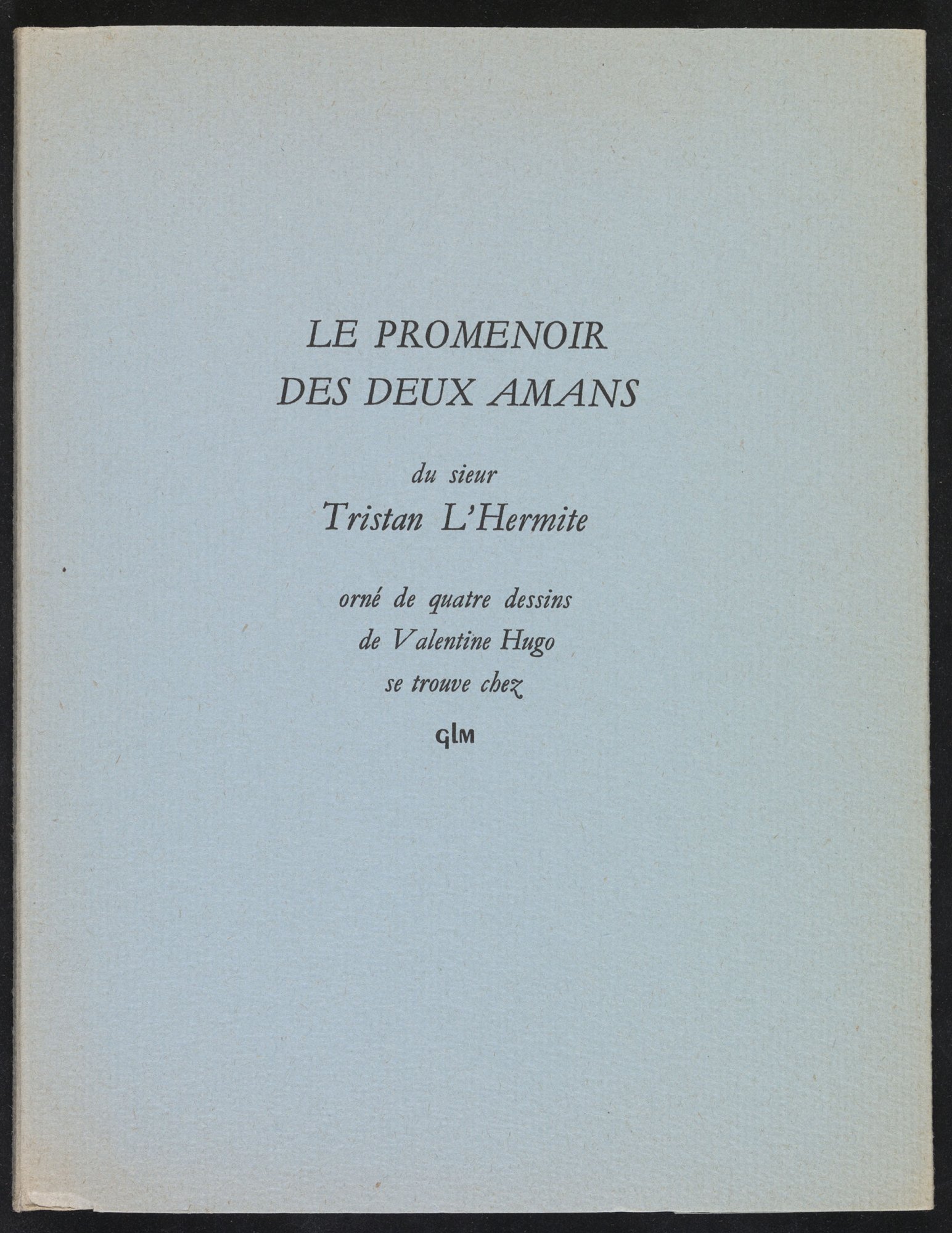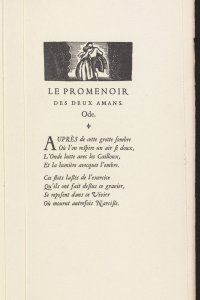Le promenoir des deux amans
Year: 1949
Author: Tristan L’Hermite (1601 - 1655)
Artist: Valentine Hugo (1887 - 1968)
Publisher: G.L.M. [Guy Lévis Mano]
Rehabilitated old texts
The genesis of this publication is thus fascinating, in several respects. Because even in the face of the renewed popularity of Tristan l’Hermite’s (1601-1655) literary work and famous poem ‘Le promenoir des deux amans’ at the beginning of the twentieth century, nothing led to believe that GLM would publish a reissue. Right from the start, Mano specialised in the publication of poetry, but since 1935 he mainly worked for the Surrealists. Many original editions, including numerous illustrations, were issued by GLM during these years. After the war he changed his output and focussed on poetry he personally appreciated. Alongside the work of talented contemporaries, he also started publishing a considerable number of translations and reissues of older texts, especially of the sixteenth century.
The layout of the French post-incunabula from the sixteenth century also inspired Mano. And this quite unadorned style, typical of the later editions of GLM, is easily recognizable in Le promenoir des deux amans. Set in Garamond, one of his six most used fonts after 1945, the reissue still looks remarkably modern. Especially when compared to the reissue of the poem by Jacques Haumont, published in August 1945, the contemporary design stands out. Haumont, devoted to publishing a faithful reproduction of the original text, only added one engraving, whereas GLM and the artist Valentine Hugo worked together to create a novel edition.
Playful curves and harmonious illustrations
From 1935 onwards Valentine Hugo, one of the most important illustrators of the Ballets Russes and the Surrealists, often illustrated books published by GLM. Living in Paris since 1907, the artist soon established her professional reputation and became part of literary and musical circles. People often designated her as ‘the Independent’, referring to her prominent desire for artistic freedom. Whereas Jean Cocteau - one of her best friends from the 1910s - called her lovingly ‘the Swan of Boulogne’ (a poetic allusion to her long neck and place of birth Boulogne-sur-Mer).
Hugo became known as a versatile artist, creating engravings, etchings and lithographies that she printed in her own studio, as well as pastel paintings or stage and costume designs. Like Mano, she worked with the Surrealists in the 1930s. In fact, she was the first woman to enter this avant-garde group when she already had a well-established artistic career. Her style remained nonetheless classical. One can discern the influences of Naturalism, Symbolism and Art Nouveau in Hugo’s work, but also those of late nineteenth-century illustrations. Flowers, animals, eyes and innumerable curves are particularly present. These themes are visible too in the four black-and-white illustrations of the love poem ‘Le promenoir des deux amans’, counting 28 stanzas and addressing one of the Oceanid nymphs in Greek mythology, Climeine. As for the style of these illustrations, Hugo clearly moved away from her typical, delicate lithos and etchings. These line drawings actually share a lot of similarities with her dynamic sketches.

![Le promenoir des deux amans, pages [8-9] with illustration by Valentine Hugo](/sites/default/files/styles/galerie/public/images/promenoir_p8-9.jpg?h=da254d66&itok=6o3WKvdx)

![Le promenoir des deux amans, page [5] with a portrait of Narcissus by Valentine Hugo](/sites/default/files/styles/galerie/public/images/promenoir_p5.jpg?h=5cd01989&itok=spQK5Xjx)
![Le promenoir des deux amans, page [13] with a portrait of Climeine by Valentine Hugo](/sites/default/files/styles/galerie/public/images/promenoir_p13.jpg?h=05bac7a8&itok=oV-xc3AY)
![Le promenoir des deux amans, page [17] with illustration by Valentine Hugo](/sites/default/files/styles/paragraph_small_no_crop/public/images/promenoir_p17.jpg?itok=bwjc_ega)